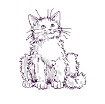|
Approach: Station
|
| Focus:
Reading comprehension. |
 |
132k |
Resources:
Story sheet. |
|
Questions
/ instructions:
 |
Cats'
Eyes
|
|
|
Some animals
hunt for their food at night. They have special eyes that help
them see when there is only a little light.
Many people
think that cats can see in the dark. This is not true. Cats cannot
see when it is completely dark, but they need much less light
than people need.
All cats,
large or small, have narrow black pupils in their eyes. These
grow larger when there is not much light, and become narrow again
when it is bright.
What about
dogs? Can they see at night? No. They have eyes like ours, with
round pupils, which also become larger when there is less light.
|
| |
|
|
|
| |
|
|
%
responses
2000 ('96)
|
|
y4
|
y8
|
| Put
a ring around the a, b or c beside the best answer. |
|
|
| 1.
Some animals can hunt at night because... |
a.
they are clever |
|
|
|
|
|
b.
they cannot see in daylight |
|
|
|
| c.
they can see when there is not much light |
|
75
(69)
|
94
(95)
|
| 2.
Can cats see when it is completely dark? |
a.
Yes |
|
|
|
|
|
b.
No |
|
74
(69)
|
92
(89)
|
|
c.
Don't know
|
|
|
|
| 3.
When are cats' pupils very narrow? |
a. When it is light
|
|
51
(51)
|
78
(77)
|
| |
b.
When it is nearly dark
|
|
|
|
|
c.
When it is completely dark
|
|
|
|
| 4.
Dogs' eyes are different from cats' eyes because dogs... |
a.
have narrow pupils
|
|
|
|
| |
b.
have round pupils
|
|
69
(61)
|
89
(89)
|
|
c.
have pupils that become smaller at night
|
|
|
|
| 5.
What does the story tell us about humans' eyes? |
a.
They have narrow pupils
|
|
|
|
| |
b.
They have round pupils
|
|
68
(68)
|
93
(91)
|
|
c.
Their pupils change when they go hunting
|
|
|
|
| 6.
Which of these do you think would have narrow pupils in their eyes? |
a.
Dogs
|
|
|
|
| |
b.
Tigers
|
|
62
(58)
|
87
(87)
|
|
c.
Humans
|
|
|
|
| |
Total
score:
|
|
|
|
|
6
|
24
(20)
|
62
(60)
|
|
5
|
22
(19)
|
23
(21)
|
|
4
|
17
(20)
|
7
(10)
|
|
3
|
15
(15)
|
5
(6)
|
|
2
|
14
(12)
|
2
(2)
|
|
0–1
|
8
(14)
|
1
(1)
|
Commentary:
Year 8 students showed distinctly better comprehension than year 4 students,
with 38 percent more year 8 than year 4 students answering all 6 questions
correctly. Seven percent more year 4 students scored perfectly, and six
percent fewer very poorly, in 2000 than in 1996. There was little difference
between 1996 and 2000 for year 8 students. |